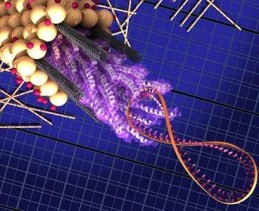Viruses improve solar-cell conversion efficiency
April 26, 2011

Artist's impression of the M13 virus, which consists of a strand of DNA (the figure-8 coil on the right) attached to a bundle of peptides (corkscrew shapes) anchored to carbon nanotubes (gray cylinders). A coating of titanium dioxide (yellow spheres) attached to dye molecules (pink spheres) surrounds the bundle (credit: Matt Klug, Biomolecular Materials Group)
Researchers at MIT have found a way to make significant improvements to the power-conversion efficiency of solar cells by using viruses to perform detailed assembly work at the microscopic level.
The researchers found that a genetically engineered version of theM13 virus, which normally infects bacteria, can be used to control the arrangement of nanotubes on a surface, keeping the tubes separate so they can’t short out the circuits, and keeping the tubes apart so they don’t clump.
The researchers tested dye-sensitized solar cells, which are lightweight and inexpensive cells consisting of an active layer of titanium dioxide, rather than the silicon used in conventional solar cells. The researchers said the same technique could be applied to quantum-dot and organic solar cells as well.
The viruses perform two different functions in the process of converting sunlight to energy. First, they possess peptides (short proteins) that can bind tightly to the carbon nanotubes, holding them in place and keeping them separated from each other. Each virus can hold five to 10 nanotubes, each of which is held firmly in place by about 300 of the peptide molecules.
Second, the virus was engineered to produce a coating of titanium dioxide (TiO2), a key ingredient for dye-sensitized solar cells, over each of the nanotubes, putting the titanium dioxide in close proximity to the wire-like nanotubes that carry the electrons.
These two functions are carried out in succession by the same virus; its activity is “switched” from one function to the next by changing the acidity of its environment. This switching feature is an important new capability that has been demonstrated for the first time in this research, the researchers said.
Adding the virus-built structures enhanced the power conversion efficiency of the dye-sensitized solar cells to 10.6 percent from 8 percent. This improvement took place even though the viruses and the nanotubes make up only 0.1 percent by weight of the finished cell.
Ref.: Paula T. Hammond & Angela M. Belcher et al., Virus-templated self-assembled single-walled carbon nanotubes for highly efficient electron collection in photovoltaic devices, April 24 online edition, Nature Nanotechnology